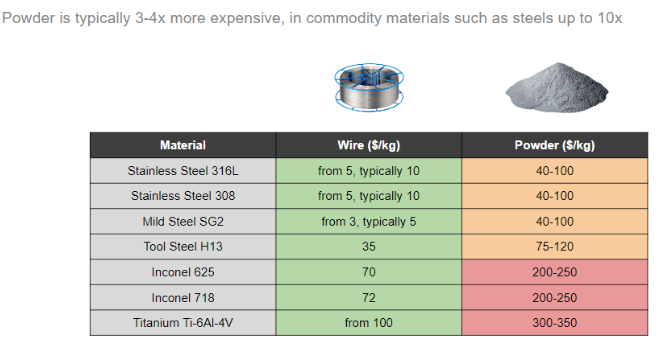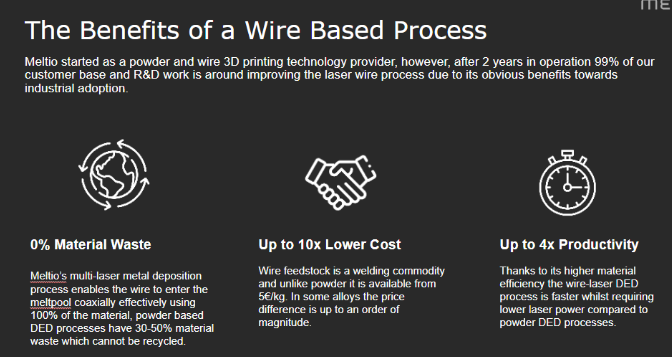As an innovative approach to additive manufacturing, wire-based 3D printing offers a range of benefits that set it apart from traditional powdered feedstock methods. Here are some of the advantages:
1. Material Waste Reduction:
Wire-based additive manufacturing processes often result in lower material waste compared to other methods that use powdered feedstock. Since the wire is consumed only as needed, there is minimal excess material, leading to cost savings and a more sustainable approach.
2. Cost-Effectiveness:
Wire feedstock usually is more cost-effective than powdered alternatives. The production and handling of wire are generally more straightforward and economical, contributing to overall lower material costs. Wire feedstock, readily available as a welding commodity, proves to be significantly more cost-effective than powders. With wire prices starting at approximately $3.00 per pound, compared to the often expensive powders, cost savings of up to 10 times can be achieved. This cost disparity can be particularly pronounced in certain alloys.
3. Enhanced Productivity:
It can be more efficient and productive, especially in continuous deposition systems. The continuous feed of wire allows for uninterrupted production, minimizing downtime and maximizing output.

4. Reduced Need for Protective Equipment:
Unlike some powdered additive manufacturing processes, wire-based methods do not involve the risk of aerial particulates. As a result, there may be reduced need for extensive protective equipment, leading to improved operator comfort and safety.
5. Facility Requirements:
Wire-based additive manufacturing processes present the advantages of facilities with limited space or specific infrastructure constraints. The simpler handling of wire feedstock requires fewer facility modifications.
6. Convenient Storage:
Wire feedstock is easier to store compared to bulkier and more cumbersome powdered materials. Wire feedstock typically requires less storage space allowing a better organization and utilization of storage areas, maximizing the available space.
7. Inventory Management:
The structured form of wire feedstock allows for easier inventory management and control. It is simpler to track the quantity of wire remaining, enabling better planning for material restocking. Moreover, wire feedstock tends to have a longer shelf life compared to some powdered materials, which may ensure the material remains usable over extended periods without degradation.

8. Reduced Contamination Risk:
Since the wire is solid and less prone to dispersal, the risk of cross-contamination between different materials is minimized. In contrast, powdered feedstock can be more susceptible to mixing or accidental spills, leading to potential material contamination.
9. Improved Handling and Transportation:
Wire feedstock is easier to handle and transport due to its solid and structured nature. Usually, it is commercialized on spools or reels, making it convenient to load into the 3D printing system.
10. Simplified Machine Clean-Up:
Wire-based additive manufacturing processes require less machine clean-up compared to powdered feedstock methods, as there is less residual material to remove after printing. This results in cleaner and tidier workspaces. There is less residue or dust, minimizing the need for frequent cleanups and contributing to a more efficient workflow.

Bonus
11. Material Change:
Switching between different materials is often more straightforward with wire-based additive manufacturing. The ability to swap wire types with relative ease can support the production of diverse components without significant downtime and also allow the printing of dual material parts.
Written by The EXBuild Team
The EXBuild Team of application engineers combined their depth of experience and industry knowledge to bring you the contents of this article.

